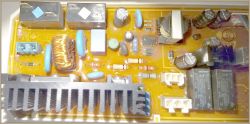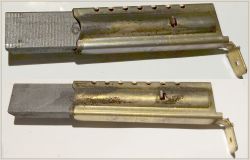Hello.
I am looking for a diagram for the Samsung WF60F4E0N0W washing machine. Yesterday she refused to obey and of course she is after the guarantee.
Symptoms:
1. During washing, she paused the washing twice (the symbols that flashed during washing stopped flashing on the display) - only pressing the start button again stimulated the washing machine to continue washing.
2. At one point, she suddenly drained the water and released error code 3E.
I turned on the diagnostic mode and it took a lot of water, and then as soon as the cycle (spinning the drum) was about to start, it immediately 'crashed' the 3E code. The same with the spin test.
I undressed the washing machine and started looking at the possible causes.
The engine looks fine. There are no signs of burning, etc.
There are a total of 8 wires in the connection block:
- 2 tachos
- 2 brushes
- 2 probably some sensor (thermal?)
- 2nd stator winding
There is a 'transition' between the brushes.
The tacho looks OK, i.e. there is a 'transition' and shows the tension while shooting.
There is a transition between the pins of the stator winding.
The thermal sensor (if it really is a sensor) also shows the transition.
I have accessed the driver board, but visually there are no damaged or blackened parts. Neither capacitor has swollen. If I tried very hard, I could see a slight color change around the 2QR2280Z chip and the LEDs nearby (marked with a red oval in the photo). However, this may be due to contamination and not to 'frying' of these items.
Since it was 1 in the morning, I didn't want to make noise anymore by testing whether the motor turns off without electronics. A diagram of the layout of this washing machine would be very useful - I would not be looking blindly. If anyone could share I'd be grateful.
Best regards,
Grzesiek
I am looking for a diagram for the Samsung WF60F4E0N0W washing machine. Yesterday she refused to obey and of course she is after the guarantee.
Symptoms:
1. During washing, she paused the washing twice (the symbols that flashed during washing stopped flashing on the display) - only pressing the start button again stimulated the washing machine to continue washing.
2. At one point, she suddenly drained the water and released error code 3E.
I turned on the diagnostic mode and it took a lot of water, and then as soon as the cycle (spinning the drum) was about to start, it immediately 'crashed' the 3E code. The same with the spin test.
I undressed the washing machine and started looking at the possible causes.
The engine looks fine. There are no signs of burning, etc.
There are a total of 8 wires in the connection block:
- 2 tachos
- 2 brushes
- 2 probably some sensor (thermal?)
- 2nd stator winding
There is a 'transition' between the brushes.
The tacho looks OK, i.e. there is a 'transition' and shows the tension while shooting.
There is a transition between the pins of the stator winding.
The thermal sensor (if it really is a sensor) also shows the transition.
I have accessed the driver board, but visually there are no damaged or blackened parts. Neither capacitor has swollen. If I tried very hard, I could see a slight color change around the 2QR2280Z chip and the LEDs nearby (marked with a red oval in the photo). However, this may be due to contamination and not to 'frying' of these items.
Since it was 1 in the morning, I didn't want to make noise anymore by testing whether the motor turns off without electronics. A diagram of the layout of this washing machine would be very useful - I would not be looking blindly. If anyone could share I'd be grateful.
Best regards,
Grzesiek





